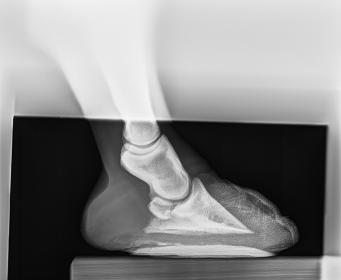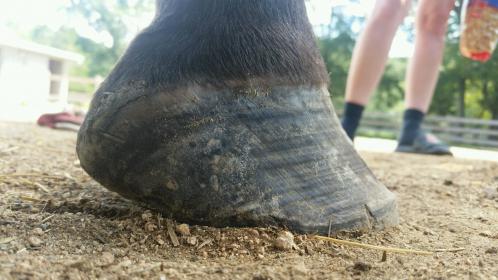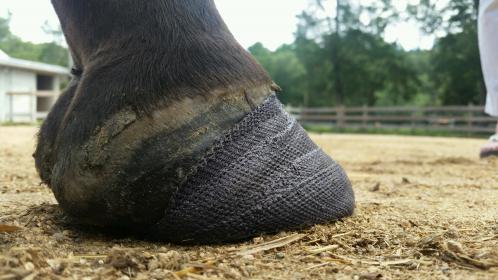The serious hoof issues this horse has had have been two-fold. When I got him he had serious underrun heels and long toes, which ended up causing some lameness issues. when the feet were getting better, but the lameness issues were continuing, we investigated further an found a coffin bone chip off the wing of the medial RF. The awesome farrier that I mentioned (that couldn’t keep coming to my barn), vet and I devised a shoeing package that keep him fairly sound, at least as sound he had ever been. This was in late 2014/early 2015. Then that farrier quit on me later spring 2015.
Late spring 2015-late summer 2016 I used the farrier (we will call him farrier #1) that got us to the point of where the first four pictures were taken. I knew things weren’t right for the last 4 shoeing cycle or so and I tried to ask questions, etc… but I was shut down pretty quickly. Then when my horse kept loosing shoes (literally all the time), I finally decided to take a break and go barefoot. The farrier pulled the remaining shoes and did an aggressive trim (I was not there for that appt) and two days later my horse couldn’t walk. Called farrier #1 numerous times to see if he could help- never heard back. Needless to say, i would never recommend this farrier.
Barefoot trimmer #1 (trimmer that casted the foot in the first 4 pics) came out a week later and lightly trimmed (basically just rasped/prepped foot for cast) and casted. You can see in the pic that the white foot (RF) was casted to raise the toe (since he was 100% positive he was rotated). horse was more comfortable (3 out of 5) for two days and then he went seriously lame (4/5, sometimes 5/5). I involved my vet by taking rads. Barefoot trimmer #1 wouldn’t work with me because I got my vet involved and put the horse on bute. Radiographs attached. Vet recommended no shoes (no foot to nail into) and 4-6 week trimming cycles. Working on trimming flare, but not to touch the heels. She said that it would take an entire 8-11 months to regrow the hoof, so we probably wouldn’t do shoes until then.
Since barefoot trimmer #1 wouldn’t work with my vet, I found barefoot trimmer #2. When barefoot trimmer #2 came out to evaluate my boy, she was quite upset about how tight the cast was on the foot and how bulked up the toe was. She told me that when we took that cast off and then started the corrective trimming process that we would probably be dealing with a lot of damage done by the cast job. From Oct 2016-July 2016 we have been dealing with LOTS of abscessing, LOTS of separation of the white line, all while we have been doing the corrective trimming and casting. This horse is extremely particular in how he’s managed. Meaning that you can never to anything too quickly or too aggressively. Barefoot trimmer #2, knows the toes are still too long and the heel still needs to come back. Believe it or not the toes and flaring in the Aug 2017 pictures look WAY better then 3-4 months ago. I wish I had been good about taking pictures all through this process.
If think someone asked when the trim was done before the Aug 2017 pictures. horse was trimmed (barefoot trimmer #2) and shod (farrier #2) on Aug 12th. He blew out a major (and I mean MAJOR) abscess under his frog Aug 21st (left front) and a different type of shoe was put on to get him up off his heel even more (to help relieve the pain).
He is right now as sound as he can be with the left heel higher then the right heel (due to the shoe on the abscess foot).








